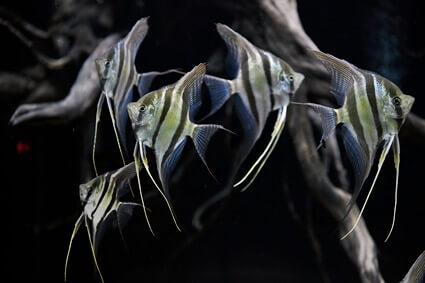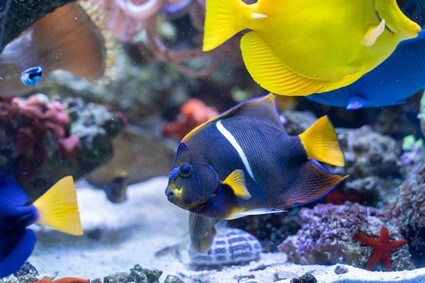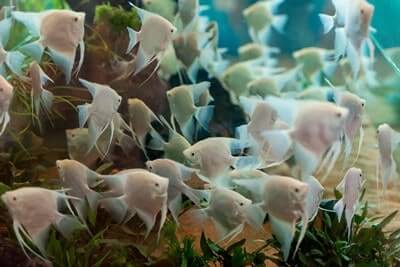There are over 90 types of angelfish, all belonging to the cichlid family. It’s OK to mix different angelfish as they all have similar water parameters and tank conditions.
Angelfish are the least aggressive cichlids. While they fight if provoked, they’re unlikely to kill each other.
Not all angelfish will get on initially. That’s why they must be introduced to ensure all fish are on an even playing field and aren’t seeking territorial dominance.
Some angelfish are bigger than others, so consider this when choosing species for the aquarium.
What Are The Different Types Of Angelfish?
There are several species of freshwater angelfish kept as pets. While they form part of the Pterophyllum genus, there are three sub-species: the altum, scalare, and leopoldi.
The scalare genus of angelfish is the most popular in captivity and hails from the Amazon Basin in Peru, Columbia, and Peru.
The altum is the larger angelfish genus but is slightly more challenging to find in captivity. The leopoldi lacks a pre-nasal notch, making it the most distinctive angelfish variety.
Within each genus, all angelfish have various patterns and colors, making them look different.
Some of the popular captive angelfish species include:
- Albino.
- Black lace.
- Blushing.
- Clown.
- Ghost.
- Golden.
- Koi.
- Leopard.
- Marble.
- Silver.
- Smokey.
- Veil.
- Zebra.
While they make good community fish, angelfish shouldn’t be placed in an aquarium with smaller prey fish, as they’re ambush predators. Many owners keep angelfish together to prevent predation.

Can Different Angelfish Live Together?
Angelfish aren’t happy alone. When they live without companionship, they become lonely and stressed. They enjoy the company of other fish, preferring to live with their species.
Similarly, angelfish will eat smaller tank mates because they’re part of the predatory cichlid family.
Angelfish tank mates shouldn’t be smaller than two inches, as they can fit them in their mouths, causing their hunting instincts to take over.
Keeping angelfish together reduces the predation risk and creates a more harmonious environment.
While angelfish can be mixed, it’s best to keep them in small shoals of 6 or more, depending on the tank’s size. For example, a shoal consisting of 6 fish requires a 60-gallon tank.
Angelfish don’t always get along at first because their personalities can clash. This is especially true if you add younger, more active angelfish to a tank containing older, slower fish.
For the angelfish to integrate, introduce them correctly from the outset.
How To Introduce Angelfish To Each Other
To minimize clashes, feed all the fish before introducing them, whether they’re already in the tank or being newly added.
Once the food has been eaten, turn out the lights and place the new angelfish in a clear container full of water. Float it in the tank and leave it for 20 to 30 minutes for the temperature to acclimate.
After this point, you can release the angelfish into the tank and allow them to get used to their new surroundings.
The benefit of feeding the fish before putting them into the tank is that they won’t compete for resources. If the angelfish in the aquarium think their new tank mates will fight them for food, they’ll become aggressive almost immediately.
If you already have angelfish in the tank, move all the decorative features to a new position. This will reset the established territories and allow the new, younger angelfish the chance to assert some dominance.
Of course, if you’re adding new angelfish simultaneously, you don’t need to do this, as the tank is already an even playing field.
While some believe that angelfish should be the same size, this isn’t necessarily true. It’s better to introduce fish that are both large and small with each other.
That’s because larger angelfish can fend for themselves. At the same time, smaller angelfish can get away from bigger fish, meaning they’re not a threat. Bigger fish soon realize this after giving chase and not catching their tank mates.
After a few minutes, the fish should feel comfortable around each other once they realize they can live in harmony.
Can Different Types Of Angelfish Breed?
Angelfish readily cross-breed. Most of today’s domestic freshwater angelfish have been created through selective breeding programs designed to develop new scale colors and patterns.
That’s because they have similar genetics and ancestors, despite what genus they come from.
Most angelfish have similar water parameter requirements, preferring temperatures between 76 and 84 degrees, making them easy to breed. However, altum angelfish prefer high temperatures and require a lower pH, so they’re not as easy to cross-breed as other angelfish species.
If you’re planning to breed angelfish, you must choose the two that are most likely to get along with each other. Otherwise, they’ll become aggressive with one another and refuse to mate.
When they eventually mate, angelfish fry will take on their parents’ dominant genes, developing the dominant fish’s attributes. However, you may also notice unique, previously unseen characteristics from “muddying” the bloodline.
Before choosing to house angelfish, consider whether they’re compatible breeding mates. As described by the Brazilian Journal of Biology, angelfish pair bonding lasts for one to three spawns. After that, they acquire new partners, continuing the cycle.
If you’re housing both male and female angelfish, you could end up with a large number of fish in only a short space of time, overpopulating the tank and causing insufficient water conditions.
As a result, if you don’t want your angelfish to breed, choose an all-female or all-male group.
How To Encourage Angelfish To Breed
For your angelfish to breed with each other, you’ll need to ensure that the water conditions and tank environment are clean and healthy. You should also provide:
- Hiding spaces in the form of plants and decorations.
- A safe and constant pH level (that’s between 6 and 8).
- A comfortable temperature (between 72 to 82 degrees Fahrenheit).
- Medium exposure to light.
- A healthy, balanced diet.
Some angelfish click instantly, regardless of the species, and will naturally mate. However, if you plan to breed different angelfish to achieve specific colors and patterns, isolate them in a separate tank.
If spawning doesn’t happen, your fish aren’t compatible, and you’ll need to try a different pairing.
The angelfish may never mate – in which case, you might want to consider leaving them be and trying again with different angelfish species that might be more compatible.
Will Angelfish Kill Each Other?
Compared to most other cichlids, angelfish are relatively peaceful and unlikely to kill each other.
However, while they’re the least aggressive cichlid species, they’re prone to chasing, fighting, and biting each other. Therefore, it’s possible they could kill each other if the tank’s conditions are bad enough.
When angelfish fight, it’s not without cause. When you have two different angelfish species living in the tank, the submissive fish will typically back down.
Angelfish become aggressive with each other for various reasons:
- Defending their territory.
- A mated pair starts ganging up on another fish.
- Protecting their fry.
- Responding to a challenge from another angelfish.
- A lone fish is cornered and feels threatened.
These issues are made worse by stress, age, mating times, and brood care.
If one of the angelfish displays noticeable injuries, such as torn fins, or seems to be picked on regularly, you must intervene to protect it.

How To Stop Angelfish Fighting
If your angelfish have natural fighting instincts, there’s not much you can do to stop them.
You can try improving your tank’s conditions by putting in more plants and hiding spaces, but that might not be enough to prevent them from fighting.
Before putting any measures in place, decide first whether there’s an underlying behavioral issue at play. For example, if your angelfish are mating, the aggression should ease once the fry is born.
However, if the fighting is merely a by-product of naturally aggressive personalities, you might need to separate the fish into separate tanks. If that’s not feasible, try placing a temporary barrier between them, such as fish-safe netting.
Another thing to remember is the link between angelfish aggression and water changes. As described by Applied Animal Behavior Science, researchers found the more water removed at one time, the more the angelfish become angry.
By removing 50% of the tank’s water at one time, you’re increasing the fish’s chances of aggression. As a result, renew only 25% of the water with each change.
What Are The Most Compatible Angelfish Tankmates?
Angelfish aren’t only compatible with their kind. There are many other fish they’re happy to live alongside and will do so without too much aggression.
If you unsuccessfully house different angelfish together, consider one of these species:
- Bolivian rams: A tolerant fish species capable of living alongside angelfish.
- Bristlenose pleco: A peaceful, easy-to-care-for fish native to the same regions as angelfish.
- Corydoras: A timid, low-maintenance species that won’t bother angelfish
- Dwarf gourami: A docile, shy fish that keeps itself scarce.
- Mollies: An adaptable fish species that can hold their own against aggressive angelfish.
- Platies: An easy-going, live-bearing fish that gets along well with most other species.
- Rainbowfish: An excellent aquarium fish that is similar in size to angelfish.
While angelfish make ideal tank mates, their personalities vary widely. Even angelfish belonging to a particular species might display slightly different behavioral traits.
You must constantly monitor the fish at first to see whether they integrate. If they don’t, you must prevent the angelfish from hurting each other.








